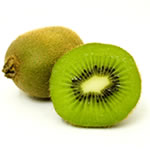Hello all and Happy Wednesday! This week we’d like to shed a special light on the  kiwifruit. Sweet with a unique texture, kiwifruit are in the peak of their season. While they are delicious snack, they have much more to offer. Let’s explore…
kiwifruit. Sweet with a unique texture, kiwifruit are in the peak of their season. While they are delicious snack, they have much more to offer. Let’s explore…
Courtesy of About.com
Kiwifruit may look unpalatable at first glance, but beneath that hairy brown exterior lies emerald green flesh with a flavor reminiscent of strawberries to some and pineapple to others. As tempting as it is in desserts, this sweet, yet slightly tart fruit also works well in savory dishes.
Cooking with Kiwifruit
Most people prefer to either peel kiwi fruit or slice in half and scoop out the flesh with a spoon. However, there are some varieties that are scarcely hairy at all, and these may be eaten skin and all if you are feeling adventurous. An egg-slicer may be used to slice peeled kiwifruit into uniform slices for recipes or as a colorful garnish.
Kiwifruit does not work well in gelatins, due to an enzyme which breaks down collagen. However, this same enzyme also makes it a great tenderizer for meat. This enzyme will also curdle milk (but not heavy cream), so you may wish to briefly cook the fruit to deactivate the enzyme when using with dairy products.
Kiwifruits are low in fat and calories and have no cholesterol. They are loaded with Vitamin C, potassium and fiber, making it one of nature’s tastiest superfoods.
Looking for ways to cook with kiwifruit? Try these recipes!
Kiwi Fruit History
Kiwifruit, Actinidia chinensis, was formerly known as the Chinese gooseberry. Surprisingly, although it is associated with New Zealand, kiwifruit actually originated in the Chang Kiang Valley of China. The Chinese used it as a tonic for children and women after childbirth due to its high nutritional value, but never truly enjoyed it as a fruit. It was first exported from Asia as an ornamental vine, perfect for arbors, in the early 1900s. The kiwifruit arrived first in 1904 in the United States and later in 1906 found its way to New Zealand. Yet it was the New Zealanders who recognized the potential of this succulent fruit and began cultivating it for commercial profit.
Due to novelle cuisine movement of the 70’s, the kiwifruit gained great popularity in the USA. New hybrids include the baby kiwis, which are green, smooth, about the size of table grapes, and eaten much like them. Today, California provides 95 percent of the US crop. Out of the four main varieties, the most popular is the “Hayward,” a variety developed by New Zealand horticulturist Hayward Wright. Luckily, the opposite growing season of New Zealand makes kiwifruit available year-round in the Northern hemisphere.
Naming the Kiwifruit
New Zealanders do not take kindly to the fruit being referred to as a kiwi, preferring kiwifruit. The kiwi is a small flightless bird native to New Zealand, a term New Zealanders often use in reference to themselves.
The moniker of “kiwifruit” is a fairly recent development, believe it or not. New Zealand growers adopted the name kiwifruit for the Chinese gooseberry in the mid 1960’s, believing it to be more palatable than a reference to the hairy bird which its hairy exterior resembles. There are also some references to the name change being in response to anti-communist sentiments implied by Chinesegooseberry.
In France, kiwifruit translates to souris vegetales, meaning vegetable mouse. It’s an apt description, albeit not very appetizing.




